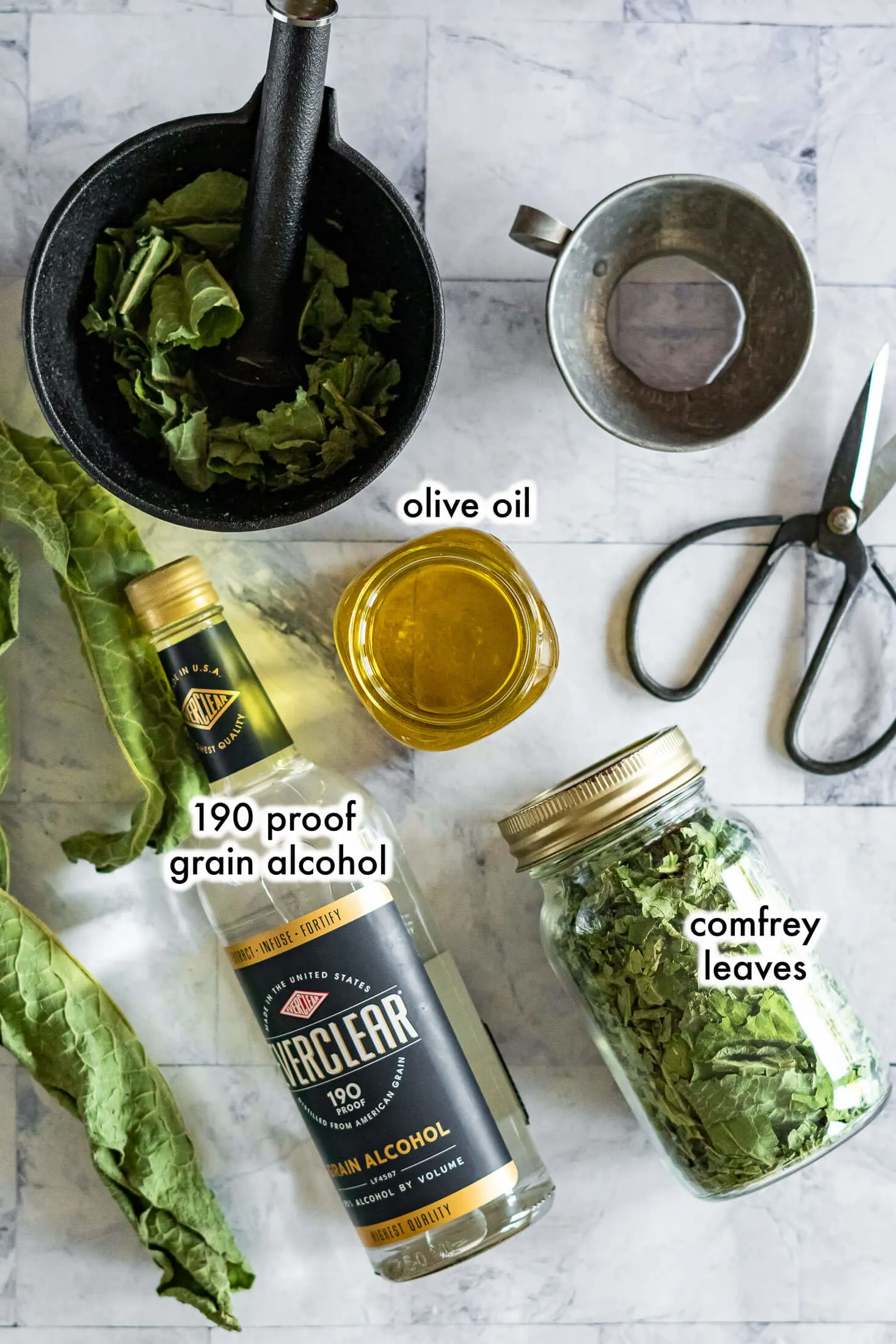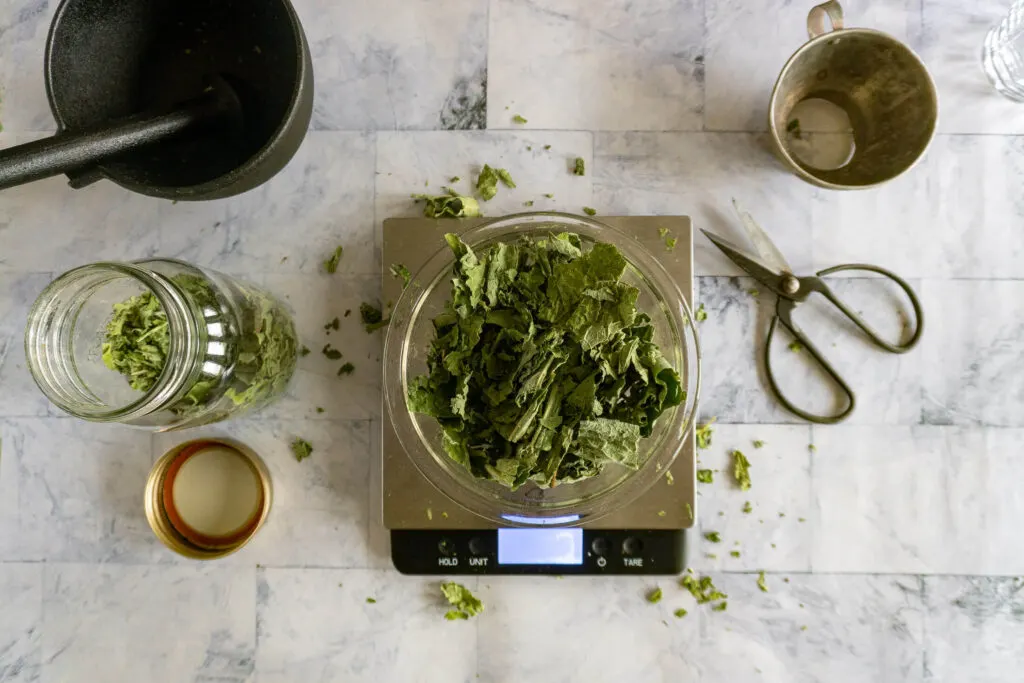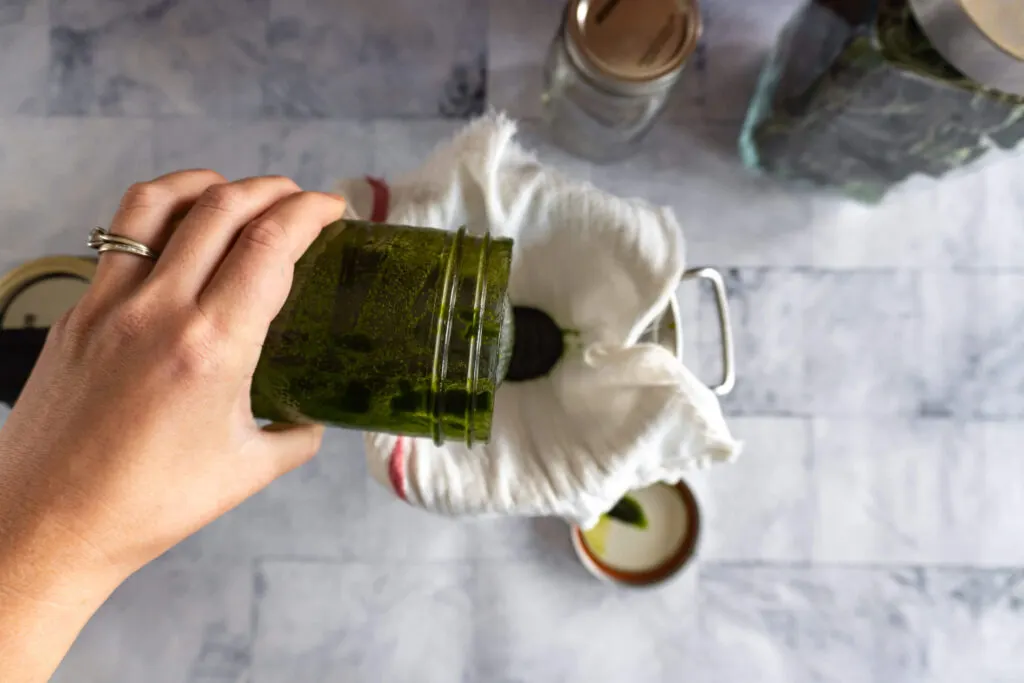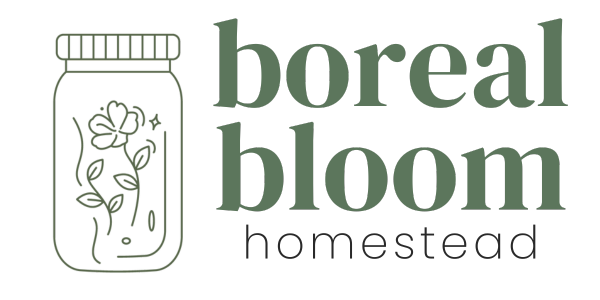So, you've done the hard work of harvesting and drying your comfrey leaves. The scent of fresh greenery still lingers in your home and the odd hair still prickles between your digits, a testament to the effort you've put into this project. Now, it's time for the best part - transforming the humble comfrey leaf into something magical: homemade comfrey infused oils.
If you're anything like me, you'll find there's something incredibly satisfying about creating your own home remedies, especially when the source is your own garden. Not only do you get to control the quality of your ingredients, but you also get to infuse every drop with your own personal love and care.

As an Amazon Associate I earn from qualifying purchases.
Jump to:
Tips + Tricks
No. 1 --> Growing your own comfrey is super easy, we have several of these amazing plants in our food forests as part of our permaculture design, but if you don't have the space to grow comfrey, you can always buy certified organic comfrey online.
No. 2 --> Choose your carrier oil based on your desired use. If you're going to turn your herbal oil into a salve, consider using olive oil. If natural skin care is at the top of your list, consider jojoba oil. While sunflower oil is a great choice for general body care formulations.
No. 3 --> When making oil infusions it's best to use dried herbs, the process is more straight forward and the dehydrated leaves of the herbs won't introduce extra moisture to the oil, hastening spoilage.
No. 4 --> The photos taken for this post are a result of the alcohol intermediary method, which is why the oil is a darker, more vibrant green. If you choose to use the folk method the resulting oil will be much paler.

Benefits Of Comfrey Infused Oil
Comfrey (Symphytum officinale), also known as knitbone, contains two powerful constituents, the first, allantoin which can improve bone, cartilage, and muscle cell growth and is included in many topical products to help speed healing. Rosmarinic acid is the second, which acts as a natural anti-inflammatory.
Studies have shown that comfrey, specifically the Russian comfrey variety (which is what we grow), has positive wound healing effects! Mount Sinai confirms that comfrey ointments have been used to help heal bruises, sprains, strains, and even pulled muscles. While Healthline has uncovered research points to comfrey's efficacy in relieving upper and lower back pain as well as osteoarthritis.

Comfrey Cautions
There are no miracle herbal remedies in the world, unfortunately, so comfrey must be used with care.
There are harmful compounds within comfrey called pyrrolizidine alkaloids. These alkaloids are extremely toxic to the liver, and thus caution should be taken when using comfrey. Comfrey should NEVER be taken internally, nor should it be used on broken skin.
The toxic compounds within comfrey are also absorbed through the skin and Mount Sinai recommends using comfrey containing products for less than 10 consecutive days and less than 42 days within a calendar year. They also recommend that those with compromised livers, alcohol dependence, or cancer avoid comfrey containing compounds. Healthline goes a step further and recommends that minors under the age of 18, pregnant or breastfeeding women and elderly people also avoid comfrey products.
Disclaimer: This article does NOT constitute medical advice, diagnostic advice, or treatment advice, as I am not a medical professional or certified herbalist. The information within this article is for entertainment purposes only. Always use sound judgment and seek guidance from your doctor before using herbal or natural remedies.

Two Methods
I'll share with you not one but two different methods to make your own comfrey oil at home.
The first method is the traditional way, often called the Folk Method or Simplers Method, and it requires a bit of patience as nature does its work. This method allows the comfrey leaves to infuse slowly, extracting their beneficial properties over time.
The second method is a quicker version for those of us who prefer near-instant gratification and also a stronger extraction. This alcohol intermediary method will speed up the process considerably, so you can start reaping the benefits of your homemade comfrey oil sooner.
Don't be alarmed, it is not nearly as complicated as it sounds - in fact, I often prefer to use the alcohol intermediary method.
Whether you're a fan of slow and steady or quick and efficient, you'll be able to choose a method to craft this herbal wonder in a way that suits your style and schedule.
Printable guide for each method located near the bottom of the page:




Folk Method / Simplers Method
In this process, you'll be filling a mason jar approximately two-thirds full of chopped or ground dried comfrey leaves, then pouring a carrier oil over the leaves ensuring they are completely covered.
From there, you'll place the jar somewhere warm and somewhere that you'll see it every day to give it a quick shake. This process takes 3-6 weeks.
Pros of the folk method include no need for electricity, fewer ingredients, and no heating of the carrier oil. The downsides are obviously the length of time required and inconsistent extraction concentration.


Alcohol Intermediary Method
This process sees you adding one ounce (by weight) of comfrey leaves to a blender and grinding until smooth - this takes about 25 seconds in my Ninja Foodi, then transferring to a clean mason jar. Then a small amount, between one-half and one fluid ounce, of high-proof grain alcohol is added to the powdered comfrey leaves and stirred to combine. Usually, it only takes me a half ounce or 1 tablespoon of Everclear.
Once the powder has been mixed with the grain alcohol, the jar is sealed and allowed to macerate for 24 hours. From there, you'll transfer the powder to the jar of your blender and add 8 ounces of your favorite carrier oil, and blend until the contents of the jar are just warm - usually about 90-120 seconds in my Foodi, before heating your oil over low heat for a couple of hours, then straining and preparing the infused oil for storage.
Benefits to using the alcohol intermediary method include faster extraction as well as more thorough extraction as different compounds are soluble in different mediums, so by using alcohol, oil, and heat we are able to extract as many soluble compounds as possible. The downsides include more upfront effort, more dishes, and requires electricity.




Storing Comfrey Oil
As with most natural products, comfrey oil is best stored in an amber or dark colored bottle, but if you don't have and prefer to use clear mason jars you already have, simply keep them in a dark place, away from direct sunlight. Sunlight can cause oxidization of the ingredients, including the compounds we are wanting to harness, breaking them down and reducing their efficacy over time.


How To Use Homemade Comfrey Oil
There are many ways to use your homemade infusion, here are some ideas!
- as a massage oil for aches, sprains, and pains.
- as an ingredient in comfrey salve
- in this herbal healing salve recipe
- as an ingredient in whipped body butter
- in this decadent beeswax lotion
More Guides Like This:
Thoughts From The Homestead
Creating your own comfrey oil at home is an enriching experience that allows you to tap into the healing properties of nature. There are two methods available to choose from, each with its own unique benefits. The Folk Method is straightforward and easy, making it a great choice for beginners or those who enjoy a slow, mindful process. However, it does require patience as it takes time for the oil to infuse.
The Alcohol Intermediary Method is a quicker alternative and is capable of extracting compounds that the Folk Method might miss, providing you with a more potent end product. Despite requiring a little more effort, the results can be well worth it, especially if you're looking for a more comprehensive extraction.
Either way, you'll end up with a handy, all-natural remedy. Just make sure to store your homemade comfrey oil properly to maintain its potency and extend its lifespan. Use it as a massage oil, add it to a healing salve, or include it in a decadent body butter.
How To Make Comfrey Oil At Home - 2 Ways!

Explore the rewarding journey of creating homemade comfrey oil. Learn about two methods - the Folk Method (Simplers Method) and the Alcohol Intermediary Method, each offering unique benefits. Dive into the world of natural wellness with this comprehensive guide to comfrey infused oil.
Materials
- dried comfrey leaves
- carrier oil such as olive, sunflower, jojoba, or sweet almond
- 190 proof grain alcohol (Everclear), optional
Tools
Folk Method:
- glass mason jar
- fine mesh strainer
- cheesecloth or linen cloth
Alcohol Intermediary Method:
- glass mason jar
- blender
- fine mesh sieve
- cheesecloth or linen cloth
Instructions
Folk Method:
- Fill a mason jar approximately two-thirds full of chopped or coarse ground dried comfrey leaves.
- Pour desired carrier oil over the leaves ensuring they are completely covered.
- Place the jar somewhere warm and somewhere that you'll see it every day to give it a quick shake for 3 - 6 weeks.
- Line a fine mesh strainer with a cheesecloth or tightly woven linen napkin and strain out the solids.
- Transfer the clarified oil to a dark amber bottle or clean mason jar, sealed tightly and stored in a cool, dark place away from direct sunlight.
Alcohol Intermediary Method:
- Add one ounce (by weight) of comfrey leaves to a blender and grind until smooth - this takes about 25 seconds in my Ninja Foodi, then transfer to a clean mason jar.
- Add a half ounce (1 tablespoon) of high proof (190 proof) grain alcohol to the powdered comfrey leaves and stir to combine. The consistency should be similar to moist sand.
- Seal the jar and macerate for 24 hours.
- Then transfer the powder to the jar of your blender and add 8 ounces of your favorite carrier oil and blend until the contents of the jar are just warm - usually about 90-120 seconds before returning the blended mixture to a clean mason jar and close the lid tightly.
- Add a couple of inches of water to a small crockpot set to keep warm, or sous vide water bath and heat to 140f, or even place the sealed jar in your dehydrator with the trays removed set to 140f.
- Heat the infused oil for 2-4 hours before removing from heat source and allowing to cool and settle for at least 12 hours.
- Strain off the solids by lining a fine mesh strainer with a cheesecloth or tightly woven linen napkin and strain out the solids.
- Transfer to to an amber apothecary bottle or clean mason jar for long term storage in a cool, dark place away from direct sunlight.
Notes
NOTE:
All of the photos taken for this how to guide are of the Alcohol Intermediary Method. I prefer this method because I believe it has a broader extraction spectrum. If you choose to use the folk method the resulting comfrey infusion will be less vibrant in color.
Pin This Guide To Making Comfrey Oil






Kathryn Shelby
Thursday 29th of February 2024
I want to use coconut oil as the carrier. Do I melt it before I mix in the blender for the 90-120 seconds? It may be quite difficult to mix the coconut oil when it is solid. Or can I just add the macerated comfrey to the melted coconut oil and heat for the 2 hours? Love your site and your instructions are very helpful. Thank you.
Ally
Thursday 29th of February 2024
Hey Kathryn, I'd just gently heat the coconut oil to melt it slightly then blitz in the blender, it will get warm and stay liquid until you've transferred it to a jar. So glad you're enjoying the articles - that's great to hear!